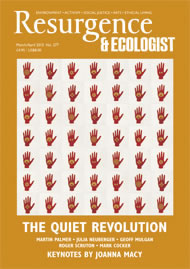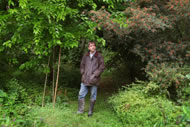I am a conservationist. I spend my days trying to save species and habitats from destruction and degradation. In England, conservation-worthy land makes up about 12% of the country, but since the Second World War we have lost half of our ancient woodlands and 95% of our flower-rich meadows, rendering more than 13,000 of our native species at risk or already extinct from these isles.
This matters. If you can get your head around the real meaning of this, then a little bit of your soul pangs at the thought of such devastation. More practically, natural systems are really clever at doing stuff that we spend a lot of time, effort and money doing artificially such as cleaning water and providing shelter. Oh, and everything good you have ever eaten has come from Nature. Let’s remember that Nature and wildlife are gifted to us three times a day, almost without fail. Nature matters.
As a conservationist I know that every species has a role and a place in the natural order of things. Just over a year ago I started to seriously question my own role. Why do my actions take without returning, and damage the environment around me where every other creature I can think of is in harmony – give-and-take, part of a complex and interconnected system?
Why are we the odd ones out in Nature?
The answer is obvious to a conservationist. Because we have squished and squeezed and sidelined Nature into 12% of the land and gone on building and ‘taking’ in the form of intensive agriculture and forestry from the remaining 88%.
We now need to rediscover an ecosystem that works for us and where Nature has a place in the 88% – one where there is complexity but where we are part of, not apart from, our habitat.
In 2011 a UK government report said just that. The Natural Choice: Securing the Value of Nature set into action the creation of 12 Nature Improvement Areas, large-scale restoration zones that will bring biodiversity back into balance with humans. These areas are not nature reserves like the remnant 12%. They are mostly farmland. But wasn’t it farmers who poisoned the land with pesticides, polluted it with fertilisers and then destroyed it with monocultures, ripping out hedgerows and draining wetlands to within an inch of their life?
Not exactly, no. Not the small-scale farmers who work and live from the land, who care about their soil, who know their landscape and tend to their craft as much as to their livestock – actually when it comes down to it, I can’t think of better hands in which to place the future of Nature. Because it was only when Nature was wrested from the individual farmers’ control in the first place that it all started to go wrong.
Conservationists have in fact been advising farmers for years on habitats such as hedgerows, ditches and wet meadows, discouraging excessive use of fertilisers and pesticides and promoting set-aside on field margins. This is good work and we should do more of it. But it is not enough. The evidence suggests there is something missing; biodiversity continues to plummet.
I believe it is the monocrops of wheat, corn, maize, potatoes and rice that are the problem.
Conservationists don’t say much about the monocrops. Even when discouraging fertilisers or pesticides, we comment little on the actual crop. But Nature needs more land, treated more kindly and connected up; this means more biodiversity in our farming.
Children of the 1950s may have experienced wild meadows about our farms. If you can find an eyewitness, ask them what that looked like. Better still, what it sounded or smelled or even tasted like. They’ll describe a countryside literally squirming with life. If you sat down in a field, you’d find yourself covered in grasshoppers, surrounded by butterflies, buzzing with bees. Take a walk in a local nature reserve today, and you’ll be delighted to see wild flowers. But this is poor by comparison, for before the war, each and every farm meadow was brimming, overflowing with flowers – not a handful, not even a dozen or 20 different kinds. It was perfectly normal for an ordinary meadow to have 50, 60 or 70 different species of flowers and grasses. A field today is for growing a single crop. The farmers (or agribusiness owners) know exactly what they are selling and exactly how much. They can control the price. The small-scale farmer has little room to manoeuvre.
But does food have to be like this? Most people already enjoy several kinds of vegetable, salad leaves and food varieties. But in Europe we have become used to a vastly reduced range of foods. We rely heavily on a few high-carbohydrate crops such as wheat and potatoes. One man who has taken the concept of biodiverse forest farming and explored it with great enthusiasm is Martin Crawford. In his ‘garden’ in Devon, Martin is growing over 200 species of edible plants, most of which you won’t find in a regular farmer’s field. But what you will find amongst his food is masses of biodiversity. It’s perfectly possible to share space and food with wildlife. We have simply taken cultivation too far, made it too simple, wiping out all but the handful of species we thought we desired the most. It was unnecessary and short-sighted, and we’ve forgotten it could ever be different. Many people are waking up to this, and what a marvellous discovery it can be for all of us: a whole new world of taste, texture and flavour.
I’m no idiot. We will probably still want a lot of those ‘staples’ such as wheat and potatoes, but we don’t have to grow these in the way we do now. Instead of planting acre after acre of monocrop wheat, another inspirational Martin (Wolfe) intersperses rows of wheat with alleys of trees and wild flowers on his farm, Wakelyns, in Suffolk. The farm is still buzzing and humming with wildlife as a result. His yields are high, and sustainably so. No fertilisers or pesticides are used, so he has no worries when oil prices rocket. The wildlife that surrounds his ‘crop’ does the job instead. The trees shade the crop from excess heat; the wild flowers attract pollinating insects, without a pest problem.
Without constant ploughing, the wild flower alleys establish deep and complex relationships with each other and with the fungi in the soil. Together they draw up nutrients from deep in the earth, share resources and protect one another from pests. They are so healthy that they can share this nutritional and health advantage with the surrounding crops. Wildlife and farming can be compatible, so why aren’t they?
Because everything I have talked about allows for food production and maintenance of farmer livelihoods, but none of it allows for greed. The biodiverse way is an equitable way. It rewards farmers, but not too much. It rewards consumers, but not too much, and it keeps the land itself in balance – taking a little, but not too much. The system we currently have is a system for feeding agribusinesses with money, and the interests of those mighty companies are strongly defended. A system without much need for oil, pesticides, fertilisers, long-distance transport, seed patenting and mass marketing is a system without much need for agribusinesses as they currently stand.
It is perfectly possible for us conservationists to have a biodiverse field and get along with small-scale farmers and eat and enjoy the fruits of all our hard work. It is not possible to have this whilst large corporations continue to dominate and control our food.
For more on Nature Improvement Areas visit www.naturalengland.org.uk








